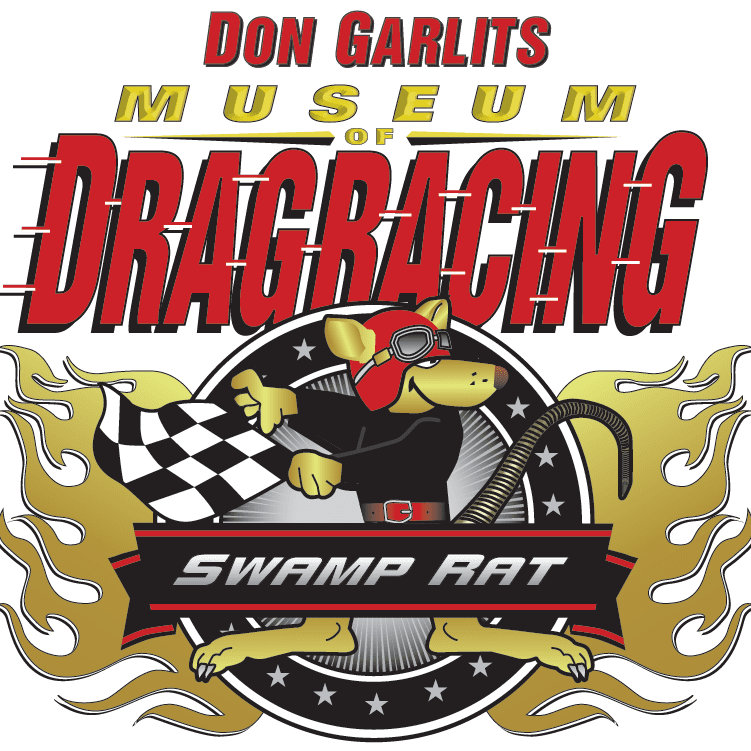2023
Thursday March 9, 2023 Hilton University of Florida Conference Center,
Gainesville Florida.
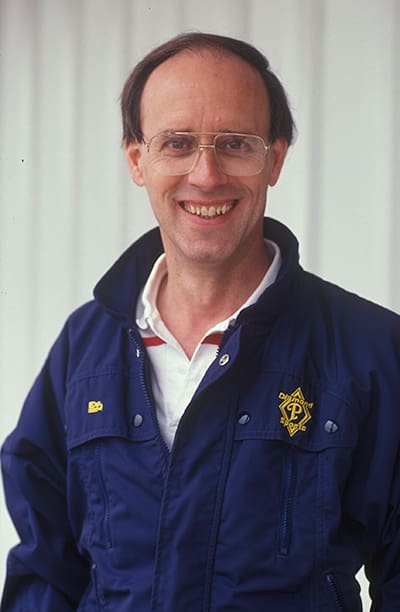
Boby Frey
Bob Frey parlayed his enthusiasm for automobiles and drag racing into an outstanding career as a journalist, an event announcer and a master of ceremonies. Bob was a member of the U.S.Air Force in 1965 but he didn’t let that keep him from his first job as a event announcer when he took the position at Atco Dragway in New Jersey in 1996. From that position, Bob began announcing NHRA divisional races in 1967 then moving over to IHRA in 1972 to announce its events through 1981.
In 1972 the first Pro National Challenge race, spearheaded by Don Garlits, was introduced, and Bob was the first announcer for this series, while also being the regular announcer for IHRA races from 1972 through 1981. Bob became NHRA’s national event announcer in 1985 and continued as such until 2012. Bob is one of very few people who has announced the rare NASCAR drag races.
Bob moved further into the TV world in 1991 as co-host for TNN’s NHRA Today show and continued his duties there until 1999. He was also the host for TNN’s live national event races from 1997 through 1999.
Bob’s multitude of honors include; Drag Racing Association of Women (DREW) 1997 Person of the Year, and Car Craft Magazine’s Special Award in 2001. Bob has been inducted into five Halls of Fame, Maple Grove Raceway Hall of Fame in 2009, the NHRA Northeast Division Hall of Fame in 2013, the Atco Dragway Hall of Fame in 2017 and, the Eastern Motorsports Press Association Hall of Fame in 2020. He is also the first ever recipient of the special NHRA Championship Ring (the only non-driver to receive this award) in 2011, the Don Prudhomme Award in 2012, and was the Grand Marshal for the 2014 NHRA New England Hot Rod Reunion.
Bob is still active in the sport as an NHRA Historian, a statistician and statistical provider for NHRA Fox Sports TV shows and special announcer at NHRA Hot Rod Reunions.
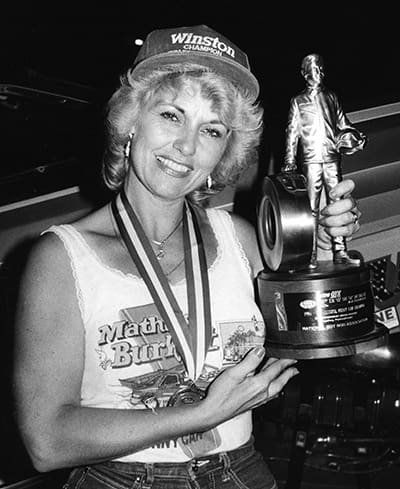
Carol “Bunny” Burkett
Carol “Bunny” Burkett married Marion Burkett when she was sixteen and one of the first gifts she received from him was a 1964 ½ Mustang. Marion, Mo to most, taught Bunny to drive at a nearby airport and then they were off to Old Dominion Speedway in Manassas, VA where she quickly became a fan favorite. This car was destroyed by a drunk driver and the young couple recognized the need for additional income to follow the dream. Carol took a hostess job at the Playboy Bunny Club in Baltimore, MD where she earned her nickname, Bunny, and together with Mo they were able to purchase a new, poppy red 1967 Mustang that became Bunny’s first dedicated race car.
In 1973, Bunny purchased a Pro Stock Ford Pinto which afforded her an opportunity to book more match races at the local tracks. Within three years, she moved from Pro Stock to a Hemi powered Top Alcohol Funny Car. In years to follow, Bunny would drive cars in almost every class with a career highlight being driving Donny Holbrook’s Top Fuel Dragster in Germany.
In terms of success and longevity, there are few drag racers with a fan base like Bunny. She was a huge attraction for fans from her start in the mid-60s right up until she passed away. Among her major achievements was winning the 1986 IHRA Top Alcohol Funny Car World Championship along with the NHRA Division II Championship and finishing fourth overall in NHRA. When Bunny won the 1986 Keystone Nationals Top Alcohol Funny Car Championship, she became the first woman in history to win an NHRA Top Alcohol event. Her record held for 25 years until Alexis DeJoria accomplished her feat in 2011.
Besides being an excellent driver, Bunny was also an excellent promoter. Unlike many of her competitors, instead of just booking into major tracks and races, she booked herself into smaller tracks and built a large and loyal fan base. She took her time with fans and would often be the last racer to pack up because she would stay until she had talked to every fan. She also successfully leveraged her newfound fame and used ‘Bunny’ as part of her booking promotion and merchandise sales. Among Bunny’s other traits that added to her popularity was her willingness to work with the news media, take time to pose for photos with her fans and to promote her crew as well as herself. Many that crewed for Bunny have gone on to work for professional teams or have become drivers in their own right.
Bunny’s racing career almost ended on Sept 4, 1995 at Beaver Springs Dragway in Pennsylvania when the car she was racing crossed over into her lane and hit her resulting in a horrific crash where the car was totally destroyed and Bunny sustained life threatening injuries including a broken back, broken arms, a broken ankle and a head injury. Those injuries could only keep her down for a year though and she returned to racing at an NHRA event at Virginia Motorsports Park in 1997.
In addition to her other many awards, Bunny received the NHRA Lifetime Achievement Award post humus at the 2020 NHRA Hot Rod Reunion in Bowling Green, KY. She was also an active supporter of Godspeed Ministries, Racers for Christ, Drag Racing Association of Women, and breast cancer research and support organizations. She loved sharing her faith in God with everyone around her and proudly displayed ‘God is my pilot’ on her cars. Carol ‘Bunny’ Burkett passed away on April 4, 2020.
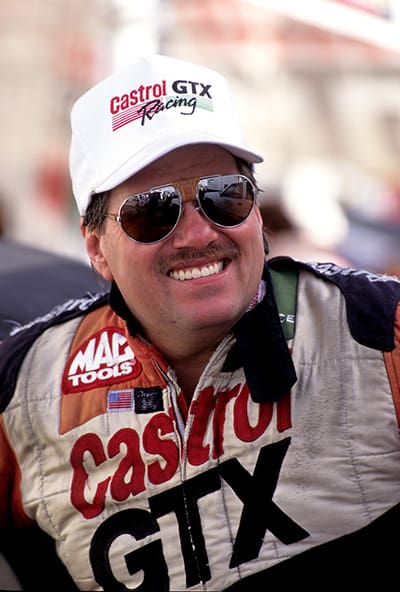
John Force
Few success stories are more compelling than those of John Harold Force, who overcame childhood polio to become the most prolific winner in professional drag racing history. The youngest of five children, his youthful dream of a having a pro football career was dashed by the effects of having polio. He could pass the football like a pro, but with one leg markedly shorter than the other, running was a problem that ultimately drew him into drag racing “where the car does the running for you.” At the outset of his racing career, with mismatched equipment and part-time crew members, he and his “Brute Force” entries were little more than fodder for the Funny Car stars of the era.
That all changed in 1985 when Force hooked up with Austin Coil in one of the most unlikely and successful collaborations in motorsports history. However, success, even with Coil, who had won two NHRA series championships with his own “Chi-Town Hustler” Funny Car, was not immediate. It would be two years before the duo finally won its first NHRA tour event at Montreal, Canada, and it would be three more seasons before Force would win the first of his remarkable 16 individual NHRA championships, a record 10 of them in succession (1993-2002).
Prior to teaming up with Coil, John was runner-up at two NHRA national events in 1979 and finished eighth in season points. In 1983, he finished fourth after two more runner-up finishes and, just one year later, was crowned Funny Car Champion in the AHRA Grand National Series. Nevertheless, it was with Coil as his crew chief that he won the first 126 of his unprecedented 155 NHRA tour titles.
At the outset of the 2023 season, his 47th on the NHRA pro tour, Force is the drag racing record holder in almost every imaginable professional category including championships, final rounds (264), race wins, round wins (1421) and No. 1 qualifying performances (165). He has at least one tour victory in 34 of the last 35 seasons including a wire-to-wire triumph in last year’s 4Wide Nationals at Charlotte, a race in which he also prevailed when it debuted in 2010. He is a five-time U.S. Nationals Funny Car Champion and the winner of 13 NHRA All-Star events including the 1998 Winston Showdown at Bristol, Tenn., in which he won a record $210,000, five Big Bud Shootouts and a pair of Traxxas Shootouts. Notably, he was the first drag racer ever named Driver of the Year for all American motor sports after winning 13 of 19 races and the championship in 1996.
For the 1996 season he expanded his team to include a second car driven to a second-place finish by Tony Pedregon. Still part of John Force Racing, Pedregon won the NHRA World Championship title in 2003 before moving on. As a result of this, Force introduced a Next Generation initiative that ultimately would develop a host of young drivers including Eric Medlen, three-time series champ Robert Hight, Force’s daughters Ashley, Courtney and Brittany, Mike Neff and, most recently, Austin Prock.
It was during his daughters’ initial involvement in the family business that Force became a reality television phenomenon as the star of the A&E series “Driving Force.” Tragically, at the height of its popularity, production on the series was suspended when Medlen, who had been prominently featured in several episodes, was killed in a 2007 testing accident at Gainesville Raceway
Force responded to Medlen’s death by leading a movement that compelled design changes to Funny Cars and Top Fuel dragsters and the implementation of new safety guidelines that reversed what had become a disturbing trend. His greatest personal triumph, however, may have been his return from life threatening injuries in a crash at the Texas Motorplex in Dallas. Despite doctors’ belief that he never would race again after his injuries, Force endured four months of intense rehab and was back in a race car to start the 2008 season. Little more than three months later, he hoisted the trophy at Topeka, Kan. He would go on to add two more series championships 2010 and 2013.
The most decorated drag racer in history, his induction into the International Drag Racing Hall of Fame completes a unique Grand Slam for the grandfather of five who was inducted into the International Motor Sports Hall of Fame in Talladega, Ala., in 2008, the Motorsports Hall of Fame of America in 2012 and the California Sports Hall of Fame in 2017.
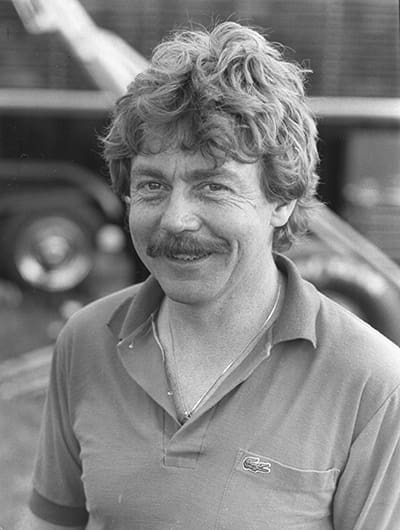
Graeme Cowin
Graeme Cowin began his racing career in the early 1960’s with a 292 Ford Y Block powered Fiat Topolino. Before long the need to go faster caused him to replace the Ford with a supercharged Chevrolet coupe. In 1973 he replaced the Chevrolet with a supercharged Chrysler powered altered roadster on nitro and began his “nitro” career.
Graeme’s first outing with a AA/Fuel Funny Car came in 1973 and was followed by a string of nitro fueled altered and funny cars all entered under the name Psycho. While he was based in Australia, Graeme competed in the Funny Car circuits of both IHRA and NHRA in 1985 and finished as runner up at the 1987 NHRA Winternationals in Pomona, CA.
In 1988, with Funny Cars losing some of their popularity in Australia, Graeme switched over to racing a supercharged Chrysler powered AA/Fuel Dragster and in 1993 became the first Australian to run under five seconds when he posted a time of 294.43 mph and 4.89 ET. After a string of wins at various racetracks, Graeme won the Australian Top Fuel Championship in 1995 and has continued to be a serious competitor over the years.
Using his involvement in the sport as a template, Graeme opened the doors to his first speed shop in 1980 under the title Rocket Industries and in 1993 he created the Outlaw Nitro Funny Car Series that became a huge success in Australia and the Rocket Allstar Series that gives non-professional category racers an opportunity to earn reward points for substantial prizes.
Graeme was inducted into the Australian National Drag Racing Association Hall of Fame in 2013 and the Australian Motorsports Hall of Fame in 2018. Graeme is not backing away from his involvement in racing and will be fielding another AA/Fuel Dragster with him as crew chief and his son Andrew doing the driving.
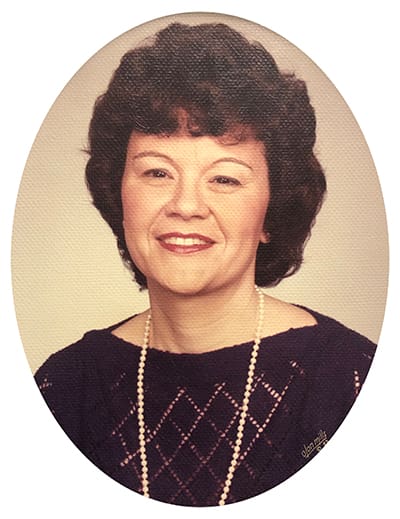
Linda Jones
Few success stories are more compelling than those of John Harold Force, who overcame childhood polio to become the most prolific winner in professional drag racing history. The youngest of five children, his youthful dream of a having a pro football career was dashed by the effects of having polio. He could pass the football like a pro, but with one leg markedly shorter than the other, running was a problem that ultimately drew him into drag racing “where the car does the running for you.” At the outset of his racing career, with mismatched equipment and part-time crew members, he and his “Brute Force” entries were little more than fodder for the Funny Car stars of the era.
That all changed in 1985 when Force hooked up with Austin Coil in one of the most unlikely and successful collaborations in motorsports history. However, success, even with Coil, who had won two NHRA series championships with his own “Chi-Town Hustler” Funny Car, was not immediate. It would be two years before the duo finally won its first NHRA tour event at Montreal, Canada, and it would be three more seasons before Force would win the first of his remarkable 16 individual NHRA championships, a record 10 of them in succession (1993-2002).
Prior to teaming up with Coil, John was runner-up at two NHRA national events in 1979 and finished eighth in season points. In 1983, he finished fourth after two more runner-up finishes and, just one year later, was crowned Funny Car Champion in the AHRA Grand National Series. Nevertheless, it was with Coil as his crew chief that he won the first 126 of his unprecedented 155 NHRA tour titles.
At the outset of the 2023 season, his 47th on the NHRA pro tour, Force is the drag racing record holder in almost every imaginable professional category including championships, final rounds (264), race wins, round wins (1421) and No. 1 qualifying performances (165). He has at least one tour victory in 34 of the last 35 seasons including a wire-to-wire triumph in last year’s 4Wide Nationals at Charlotte, a race in which he also prevailed when it debuted in 2010. He is a five-time U.S. Nationals Funny Car Champion and the winner of 13 NHRA All-Star events including the 1998 Winston Showdown at Bristol, Tenn., in which he won a record $210,000, five Big Bud Shootouts and a pair of Traxxas Shootouts. Notably, he was the first drag racer ever named Driver of the Year for all American motor sports after winning 13 of 19 races and the championship in 1996.
For the 1996 season he expanded his team to include a second car driven to a second-place finish by Tony Pedregon. Still part of John Force Racing, Pedregon won the NHRA World Championship title in 2003 before moving on. As a result of this, Force introduced a Next Generation initiative that ultimately would develop a host of young drivers including Eric Medlen, three-time series champ Robert Hight, Force’s daughters Ashley, Courtney and Brittany, Mike Neff and, most recently, Austin Prock.
It was during his daughters’ initial involvement in the family business that Force became a reality television phenomenon as the star of the A&E series “Driving Force.” Tragically, at the height of its popularity, production on the series was suspended when Medlen, who had been prominently featured in several episodes, was killed in a 2007 testing accident at Gainesville Raceway
Force responded to Medlen’s death by leading a movement that compelled design changes to Funny Cars and Top Fuel dragsters and the implementation of new safety guidelines that reversed what had become a disturbing trend. His greatest personal triumph, however, may have been his return from life threatening injuries in a crash at the Texas Motorplex in Dallas. Despite doctors’ belief that he never would race again after his injuries, Force endured four months of intense rehab and was back in a race car to start the 2008 season. Little more than three months later, he hoisted the trophy at Topeka, Kan. He would go on to add two more series championships 2010 and 2013.
The most decorated drag racer in history, his induction into the International Drag Racing Hall of Fame completes a unique Grand Slam for the grandfather of five who was inducted into the International Motor Sports Hall of Fame in Talladega, Ala., in 2008, the Motorsports Hall of Fame of America in 2012 and the California Sports Hall of Fame in 2017.
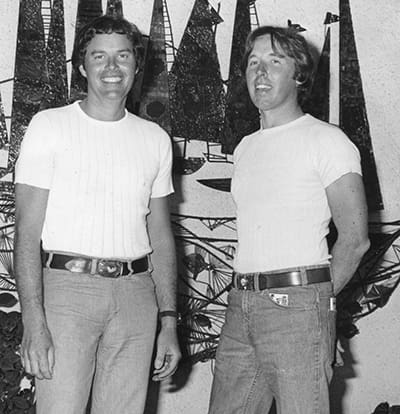
Vinny & Richard Napp
The Napp brothers, Vinny and Richard, began their involvement in drag racing as soon as they became owners of their first car while still in their teens. The closest legal place for them to run was the front straightaway of the Old Bridge Speedway located in Englishtown, NJ. While they enjoyed their race participation, they soon became more interested in finding a place where racers could compete safely. In the early 1960’s the Napp brothers began looking for land to build a drag strip on that was affordable and located within a community that was open to such an operation. In 1962 they found 308 acres of wooded land just outside Old Bridge Township, NJ, that fit their needs and in 1965 they opened the gates at Raceway Park.
Like all new operations, opening day had its glitches but with the brother’s attention to detail and help from the racers, it soon found a workable groove. Before long racers from as far away as Pennsylvania and New England were racing there and the track was building a reputation as a “solid and fair” place to compete at. Raceway Park also caught the attention of NHRA and in 1968 it debuted its Summernationals there with an impressive spectator attendance of over 85,000. In 1971, NHRA awarded the Napp brothers the permanent placement of its Summernationals but its off-season nitro match racing really made it a complete success both with the racers and fans.
Vinny and Richard never rested on their success but constantly found new ways to upgrade and improve the facility. They were one of the first tracks to feature a 32 car Funny Car show, book a jet car shoot out and to bring in special match race events. They were also very good at promoting their events and finding ways to highlight unusual activities in their ads, such as Don Garlits famous “blow over” in 1986.
In 2018, after 53 years of superb racing events and shows, the brothers bowed to various pressures and closed the gates of Raceway Park. Sadly, Vinny passed away in October of 2019 and Richard passed away in December of 2021 but they will be long remembered by thousands of racers and race fans.

Ron Attebury
It has been reported that Ron began his car building business at the ripe old age of five when his parents gave him a pedal tractor and he started taking body panels off it to make it lighter and faster. When he was 7, Ron started racing go karts after his father opened a go kart club in Los Gotos, CA. One of the true influencers in Ron’s life is his brother in law, Jack Castella, who is the holder of several Land Speed Records. In 1969 at the ripe old age of 20, Ron, along with his brother Raymond, built and raced his first real race car, a supercharged Chrysler powered AA/Gas Dragster. Ron drove this car to his first major class win at the WCS event at Bakersfield, CA in 1973.
In 1975 Ron built his first “for pay” car, a AA/Fuel Dragster for Frank Bradley that opened the door to Ron’s future as a chassis builder when Frank won the 1976 NHRA season opener Winternationals at Pomona, CA. Ron’s list of clientele after this reads like a Who’s who including Gary Beck, Warren and Coburn, Dennis Baca, Tommy Ivo and Shirley Muldowney to name just a few. One of the things that set Ron apart from some of his competitors was the fact he was also a racer so he knew first hand what other drivers and crews looked for in a car.
Ron and Jungle Jim Liberman soon became close friends and in 1977, Ron moved to Pennsylvania to become the only open wheel car to be part of the Jungle Jim racing team. 1978 found Ron back in California working out of his parents garage where he built Ivo’s first jet car. Later that year Ron changed careers by going to work at the U.S. Department of Energy’s Stanford Linear Accelerator Center. Before long Ron realized he liked building cars more than the government job so in 1983 he opened Atterbury’s Street Rods in Morgan Hill, CA and began producing some of the most outstanding street rods to grace the streets with some of them competing for the Most Beautiful Street Roadster award at the Grand National Roadster show over the years. Many of his street rods also found their way onto the pages of various magazines over the years and two of the race cars he built for Tommy Ivo were featured on the cover of Hot Rod Magazine. It needs to also be noted that one of his Jungle Jim Funny Cars became a Johnny Lightning die-cast model.
In 2001 the racing bug bit Ron again so he built himself an A/Fuel Dragster to compete in the GoodGuys Nostalgia circuit. In 2003 Ron won the coveted GoodGuys A/Fuel Dragster Championship title and retired from driving again. The “bug” bit Ron again in 2009 and he built his last race car, a gas powered, modified roadster he last raced at Bonneville in 2012. Ron retired in 2019 but he is still considered to be one of the premier dragster chassis and outstanding street rod builders ever.
In 1971 Ron was elected as one of Car Craft Magazines elite Hi Risers and in 2021 he was one of the NHRA Hot Rod Reunion Honorees. Today, Ron is still working out of his shop in Grass Valley, CA producing award winning street rods.
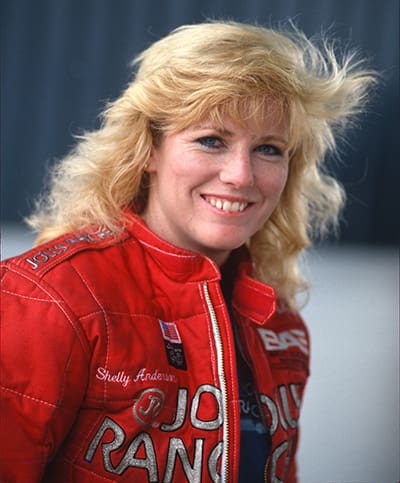
Shelly Anderson
Shelly Anderson-Payne is a second generation, award winning, enthusiast. Shelly followed in her father’s, Brad Anderson, footsteps as a crew member and ultimately a top ranked driver. As a teenager, she could be found working with her father’s crew doing everything from cleaning parts to working on the car, learning the intricacies of the sport. Brad’s sponsor at that time was Jolly Rancher candies that liked the way the family worked together and offered Shelly a Top Fuel ride. At that time, Shelly was in her last year of college and Brad insisted she graduate before becoming a full time racer.
Shelly earned her NHRA dragster license in 1991 and began her driving career at the wheel of a supercharged Chrysler powered AA/Alcohol Dragster and notched her first national event win that same year at the NHRA Southern Nationals in Atlanta, GA. Shelly made the switch from Alcohol fueled cars to Nitro Fuel in 1992 at the wheel of a supercharged Chrysler powered AA/Fuel Dragster and posted her first national AA/Fuel Dragster win at the NHRA Keystone Nationals in Reading, PA.
In 1998 she experienced a ‘double tire explosion’ that sent her into the guardrail at over 300 mph and left her with third degree burns on both legs and her left arm and hand. Upon her release from the burn hospital, Shelly went to Indianapolis, IN to compete in the NHRA U.S. Nationals.
Shelly finished the 1998 season in the car but the next year she retired from driving and accepted a position at ESPN as a drag racing commentator where she was able to present a unique overview of the sport. After working on the NHRA shows for two and a half years, Shelly took time off to have her daughter, Madison.
She earned her Pro Mod license in 2004 and moved into the seat of a Dodge Stratus Pro Mod car until she briefly retired from driving to deliver son, Toby. While she was extremely competitive in this class, in 2005 she was involved in two terrible crashes. Between the two crashes, she suffered two broken vertebrae and multiple cuts and bruises for which she underwent corrective surgery. Upon her release from the hospital Shelly returned to compete at the AMS Pro Mod Challenge season opener at the NHRA Gatornationals in Gainesville, Fl in 2006. Her first national win in Pro Mod came later that year at the NHRA Pro Mod Challenge in Dallas, TX.
During her AA/Fuel Dragster days, Shelly won four NHRA National events, and the Budweiser Classic.
She is still totally involved in the sport working full time with husband Jay who competes with his AA/Alcohol dragster, and the husband-wife team both help their son Toby and daughter Madison who both compete in the Super Comp class and cheer Madison on when she is at the wheel of Duane Shields A/Fuel dragster.
